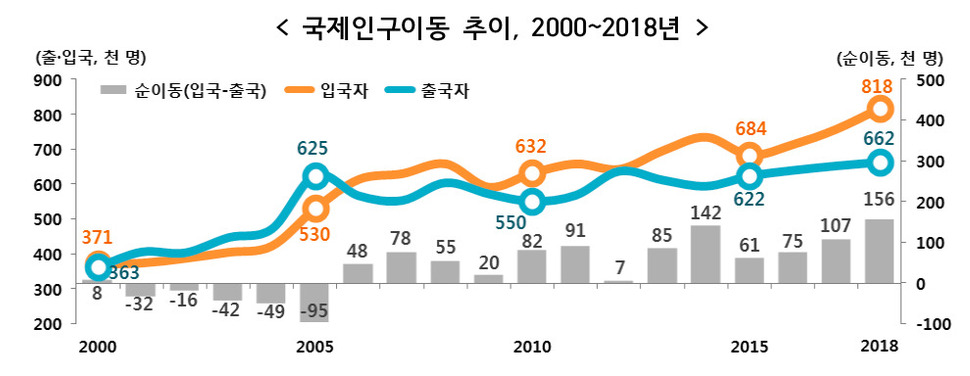 |
|
2018 international population movement statistics published on July 18 by Statistics Korea
|
Influx of foreign residents resulting from Pyeongchang Olympics and K-pop’s global influence
Among international residents in South Korea who arrived last year and have stayed for over 90 days, a total of 195,000, or 39.5%, entered with permission for a short-term stay of up to 90 days. In other words, nearly four out of every 10 long-term international residents is staying illegally. According to 2018 international population movement statistics published on July 18 by Statistics Korea, some 818,000 foreign nationals have remained in South Korea for a period of 90 days or more since arriving from overseas – an increase of 60,000 (7.9%) over the year before. In contrast, the number of people from South Korea staying in foreign countries for a period of more than 90 days stood at 662,000, up by 11,000 (1.6%) from 2017. This translated into a net influx of 156,000 people to South Korea last year. The numbers of entries, departures, and net arrivals were all the largest since statistics were first compiled in 2000. The total included 495,000 foreign nationals arriving from overseas, up by 42,000 (9.4%) from the year before. At 365,000, the number of departures was up by 16,000 (4.7%). The net influx of foreign nationals totaled 130,000, or 26,000 more (25%) than the year before. Three countries – China, Thailand, and Vietnam – accounted for 61.7% of entries by foreign nationals. China accounted for the largest shares of both entries and departures, with 169,000 of the former and 151,000 of the latter. By net arrivals (entries minus departure), Thailand ranked first with 41,000, followed by Vietnam with 28,000 and China with 19,000. In terms of sojourn status, 39.5% of arriving foreign nationals were on short-term stays (195,000 people), while 25.4% (126,000) had employment visas, 13.9% (69,000) had study-abroad/general training visas, and 11.1% (55,000) were overseas Koreans. The rise in entries by foreign nationals was seen as being influenced by the Pyeongchang Winter Olympics and the Korean Wave in popular culture. “At the time of the Pyeongchang Olympics last year, entries without visas were allowed on a limited-time basis to attract overseas tourists. Many foreign nationals entered with short-term visas during that period,” a Statistics Korea official explained. “The number of Chinese study-abroad students also rose significantly last year as relations with China improved after dropping in 2017 due to the conflict over THAAD [the Terminal High Altitude Area Defense anti-missile system],” the official added. “A lot of people also entered from Vietnam and other countries for general training due to the Korean Wave boom in Southeast Asia.” But recent trends show an increase in the number of foreign nationals tallied as “illegal sojourners” for stays of longer than 90 days after entering with permissions for a stay of up to 90 days. The percentage has risen from 29.8% in 2015 to 30.4% in 2016, 38.6% in 2017, and 39.5% last year. Short-term sojourns include cases where visitors receive visa status of B1 (visa exemption), B2 (transit visa), and C3 (short-term visa). By Lee Kyung-mi, staff reporter Please direct comments or questions to [english@hani.co.kr]






